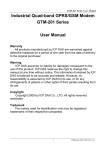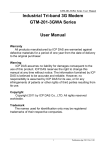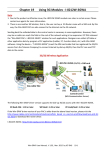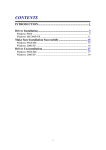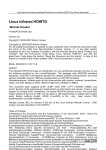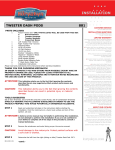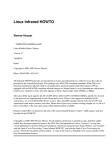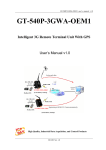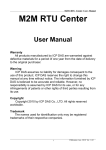Download User Manual - ICP DAS USA`s I
Transcript
I-8212W/I-8213W User Manual Industrial 2G/3G module I-8212W/I-8213W I-8212W-3GWA/I-8213W-3GWA User Manual Warranty All products manufactured by ICP DAS are warranted against defective materials for a period of one year from the date of delivery to the original purchaser. Warning ICP DAS assumes no liability for damages consequent to the use of this product. ICP DAS reserves the right to change this manual at any time without notice. The information furnished by ICP DAS is believed to be accurate and reliable. However, no responsibility is assumed by ICP DAS for its use, or for any infringements of patents or other rights of third parties resulting from its use. Copyright Copyright 2011 by ICP DAS Co., Ltd. All rights reserved worldwide. Trademark The names used for identification only may be registered trademarks of their respective companies. 1 Publication Aug, 2011 Ver. 1.01 I-8212W/I-8213W User Manual Table of Contents Chapter 1 Introduction ...................................................................... 3 Chapter 2 Hardware Specifications .................................................. 4 2.1.1 I-8212W/I-8213W ....................................................................................... 4 2.1.2 I-8212W/I-8213W Specifications ............................................................. 5 2.1.3 I-8212W/I-8213W Features ...................................................................... 7 2.2.1 I-8212W-3GWA/I-8213W-3GWA ............................................................. 8 2.2.2 I-8212W-3GWA/I-8213W-3GWA Specifications ................................... 9 2.2.3 I-8212W-3GWA/I-8213W-3GWA Features .......................................... 11 Chapter 3 Application architecture ................................................. 12 Chapter 4 Hardware Appearance ................................................... 13 4.1 Pin Assignments .......................................................................................... 13 4.2 Hardware Dimensions ................................................................................ 15 4.3 LED indicators ............................................................................................. 17 Chapter 5 Hardware Installation ..................................................... 19 5.1 SIM card Installation ................................................................................... 19 5.2 Antenna Installation..................................................................................... 19 5.3 Install I-8212W/ I-8213W / I-8212-3GWA / I-8213-3GWA module ...... 20 5.3.1 XP-8000 (Windows Embedded Standard 2009) .............................................. 20 5.3.2 WinPAC-8000 (WinCE 5.0 Based) ..................................................................... 27 5.3.3 iPAC-8000 (miniOS7 Based) ............................................................................... 31 5.3.4 LinPAC-8000 (Linux kernel 2.6 based) .............................................................. 32 Chapter 6 GPRS connection .......................................................... 33 6.1 XP-8000 (Windows Embedded Standard 2009) .................................... 33 6.2 WinPAC-8000 (WinCE 5.0 Based) ........................................................... 48 6.3 LinPAC-8000 (Linux kernel 2.6 based) .................................................... 59 Chapter 7 Quick test GPS (I-8213W /I-8213W-3GWA only) .......... 62 7.1 XP-8000 (Windows Embedded Standard 2009) .................................... 62 7.2 WinPAC-8000 (WinCE 5.0 Based) ........................................................... 63 7.3 iPAC-8000 (miniOS7 Based) ..................................................................... 64 7.4 LinPAC-8000 (Linux kernel 2.6 based) .................................................... 65 2 Publication Aug, 2011 Ver. 1.01 I-8212W/I-8213W User Manual Chapter 1 Introduction The I-8212W/I-8213W is an industrial Quad-band GSM/GPRS module with GPS function (only I-8213W) that work on frequencies of 850/900/1800/1900 MHz. The I-8212W-3GWA/I-8213WA is an industrial Tri-band 3G module with GPS function (only I-8213W-3GWA) that work on frequencies of WCDMA 2100/1900/850 MHz and GSM 850/900/1800/1900 MHz. These modules utilize the 2G/3G network for convenient and inexpensive data transfer from remote instruments, meters, computers or control systems in either live data or packet data. These modules have the integrated TCP/IP stack so that even simple controllers with serial communications ports can be connected to the modem without the need for special driver implementation. With the features of theirs, the systems can be SMS and GPRS or 3G connection applications with our PAC series like iPAC-8000, WinPAC-8000, LinPAC-8000 or XP-8000. 3 Publication Aug, 2011 Ver. 1.01 I-8212W/I-8213W User Manual Chapter 2 Hardware Specifications 2.1.1 I-8212W/I-8213W Model: I-8212W Model: I-8213W 4 Publication Aug, 2011 Ver. 1.01 I-8212W/I-8213W User Manual 2.1.2 I-8212W/I-8213W Specifications Models I-8212W I-8213W GSM/GPRS System GPRS/GSM Quad-band 850/900/1800/1900 MHz GPRS Multi-slot Class 10/8 GPRS Mobile Station Class B GPRS Class 10 Max. download speed 85.6 kbps; Uplink transfer: Max 42.8 kbps CSD Up to 14.4 kbps Compliant to GSM Phase 2/2+ MT, MO, CB, Text and PDU mode Coding Schemes CS 1, CS 2, CS 3, CS 4 SMS Text and PDU Mode GPS System Support Channels - 32 - Tracking = up to -159 dBm (with external LNA) Cold start = up to -146 dBm (with external LNA) Acquisition Time - Hot start (Open Sky) = 2 sec.(typical) Cold start (Open Sky) = 36 sec.(typical) Protocol Support - NMEA 0183 version 3.01 Sensitivity LED Indicators Power Red color GSM/GPRS Yellow color GPS - Green color Power Frame Ground Protection ESD, Surge, EFT, Hi-Pot Power Consumption Idle: 0.16 A @ 5 VDC; Data Link: 0.2 ~ 1.64 A (peak) @ 5 VDC Mechanical Casing Plastic Dimensions 30 mm x 85 mm x 114 mm 5 Publication Aug, 2011 Ver. 1.01 I-8212W/I-8213W User Manual (W x L x H) Environment Operating Temperature -25 °C ~ +75 °C Storage Temperature -30 °C ~ +80 °C Humidity 5 ~ 95% RH, non-condensing Note1: The default setting of GSM/GPRS module is as following on I-8212W/I-8213W. Parameters Default value Baud rate 115200 bps Parity None Date bit 8 Stop bit 1 Note2: The default setting of GPS module is as following on I-8213W. Parameters Default value Baud rate 9600 bps Parity None Date bit 8 Stop bit 1 6 Publication Aug, 2011 Ver. 1.01 I-8212W/I-8213W User Manual 2.1.3 I-8212W/I-8213W Features Quad-band GSM/GPRS Modem Operating on 850/900/1800/1900 MHz 4 KV ESD Protection Designed for GPRS and SMS Applications Support TCP Server, TCP Client, UDP Client Connection stack from GPRS Support Standard AT Commands LED Indicators for Power, GSM and GPS(only I-8213W) Indication High Reliability in Harsh Environment Support 32-channels GPS and NMEA v0183 v3.01(only I-8213W) PPS: 100 ms pulse output/sec for precise timekeeping and time measurement(only I-8213W) Support XP-8000, WinPAC-8000, LinPAC-8000, ViewPAC, iPAC-8000 7 Publication Aug, 2011 Ver. 1.01 I-8212W/I-8213W User Manual 2.2.1 I-8212W-3GWA/I-8213W-3GWA Model: I-8212W-3GWA Model: I-8213W-3GWA 8 Publication Aug, 2011 Ver. 1.01 I-8212W/I-8213W User Manual 2.2.2 I-8212W-3GWA/I-8213W-3GWA Specifications Models I-8212W-3GWA I-8213W-3GWA 3G System Frequency Band UMTS : 2100/1900/850 MHz Data Transmission UMTS / HSDPA / HSUPA Downlink transfer: Max. 7.2Mbps; Uplink transfer: Max 5.76Mbps GSM/GPRS System Frequency Band 850/900/1800/1900 MHz GPRS connectivity GPRS class 12/10; GPRS station class B DATA GPRS Downlink transfer: Max. 85.6 kbps; Uplink transfer: Max 42.8kbps CSD Max. download speed 85.6 kbps; Uplink transfer: Max 42.8 kbps Coding Schemes CS 1, CS 2, CS 3, CS 4 SMS System SMS MT, MO, CB, Text and PDU mode GPS System Support Channels - 32 - Tracking = up to -159 dBm (with external LNA) Cold start = up to -146 dBm (with external LNA) Acquisition Time - Hot start (Open Sky) = 2 sec.(typical) Cold start (Open Sky) = 36 sec.(typical) Protocol Support - NMEA 0183 version 3.01 Sensitivity LED Indicators Power Red color GSM/GPRS Yellow color GPS - Green color Power Frame Ground Protection ESD, Surge, EFT, Hi-Pot Power Consumption Idle: 0.16 A @ 5 VDC; Data Link: 0.2 ~ 1.64 A (peak) @ 5 VDC Mechanical Casing Plastic Dimensions 30 mm x 85 mm x 114 mm 9 Publication Aug, 2011 Ver. 1.01 I-8212W/I-8213W User Manual (W x L x H) Environment Operating Temperature -25 °C ~ +75 °C Storage Temperature -30 °C ~ +80 °C Humidity 5 ~ 95% RH, non-condensing Note1: The default setting of the module is as following on I-8212W-3GWA/I-8213W-3GWA. Parameters Default value Baud rate 115200 bps Parity None Date bit 8 Stop bit 1 Note2: The default setting of GPS module is as following on I-8213W-3GWA. Parameters Default value Baud rate 9600 bps Parity None Date bit 8 Stop bit 1 10 Publication Aug, 2011 Ver. 1.01 I-8212W/I-8213W User Manual 2.2.3 I-8212W-3GWA/I-8213W-3GWA Features Supports Tri-band UMTS 2100/1900/850 MHz and Quad-band GSM 850/900/1800/1900 MHz 4 KV ESD Protection Designed for WCDMA, GPRS and SMS Applications Supports TCP Server, TCP Client, UDP Client Connection stack from 3G or GPRS Support Standard AT Commands LED Indicators for Power, GSM and GPS(only I-8213W-3GWA) Indication High Reliability in Harsh Environment Support 32-channels GPS and NMEA v0183 v3.01(only I-8213W-3GWA) PPS: 100 ms pulse output/sec for precise timekeeping and time measurement(only I-8213W-3GWA) Support XP-8000, WinPAC-8000, LinPAC-8000, ViewPAC, iPAC-8000 11 Publication Aug, 2011 Ver. 1.01 I-8212W/I-8213W User Manual Chapter 3 Application architecture Application 1 Application 2 12 Publication Aug, 2011 Ver. 1.01 I-8212W/I-8213W User Manual Chapter 4 Hardware Appearance 4.1 Pin Assignments I-8212W I-8213W 13 Publication Aug, 2011 Ver. 1.01 I-8212W/I-8213W User Manual I-8213W-3GWA I-8213W-3GWA 14 Publication Aug, 2011 Ver. 1.01 I-8212W/I-8213W User Manual 4.2 Hardware Dimensions I-8212W / I-8212W-3GWA 15 Publication Aug, 2011 Ver. 1.01 I-8212W/I-8213W User Manual I-8213W / I-8213W-3GWA 16 Publication Aug, 2011 Ver. 1.01 I-8212W/I-8213W User Manual 4.3 LED indicators There are three LED indicators to help users to judge the various conditions. The description is as following: PWR(Red):The PWR LED can indicate the status of Power module. Power normal Power fail Always on Always off GSM/GPRS (Yellow):The modem LED can indicate the status of GSM module for I-8212W/I-8213W. Modem normal Blanking (3 sec) Modem fail Off or Blanking (not 3 sec) 3G (Yellow) : The modem LED can indicate the status of GSM module for I-8212W-3GWA/I-8213W-3GWA. Modem normal Blanking (0.8 sec) Modem fail OFF or ON 17 Publication Aug, 2011 Ver. 1.01 I-8212W/I-8213W User Manual GPS (Green):The GPS LED can indicate the status of GPS module.(I-8213W / I-8213W-3GWA only) GPS Fail Search GPS Receive GPS data Always off Always on Blanking (1 sec) 18 Publication Aug, 2011 Ver. 1.01 I-8212W/I-8213W User Manual Chapter 5 Hardware Installation 5.1 SIM card Installation 5.2 Antenna Installation 19 Publication Aug, 2011 Ver. 1.01 I-8212W/I-8213W User Manual 5.3 Install I-8212W/ I-8213W / I-8212-3GWA / I-8213-3GWA module 5.3.1 XP-8000 (Windows Embedded Standard 2009) Install module. 1. Install the module on the XP-8000. 2. Rotate the Rotary Switch as “2”. To disable EWF (ENHANCED WRITE FILTER). 3. Reboot your XP-8000 4. After reboot, execute the “Multi-Port IO module Register Wizard”. 4.1 Open Multi-Port IO Module Register Wizard, Start => ICPDAS => Multi-Port IO Module Register Wizard 20 Publication Aug, 2011 Ver. 1.01 I-8212W/I-8213W User Manual 4.2 Register the module and select “Exit” 4.3 Select “OK” and reboot. 21 Publication Aug, 2011 Ver. 1.01 I-8212W/I-8213W User Manual 4.4 After reboot, XP-8000 will install ports of the module. 5 After finishing, rotate the Rotary Switch as “0” to enable EWF. 22 Publication Aug, 2011 Ver. 1.01 I-8212W/I-8213W User Manual Uninstall module 1. Rotate the Rotary Switch as “2” to disable EWF. 2. Reboot your XP-8000 3. After reboot, ensure the module is installed on XP-8000 and execute the “Multi-Port IO module Register Wizard”. 3.1 Open Multi-Port IO Module Register Wizard, Start => ICPDAS => Multi-Port IO Module Register Wizard 23 Publication Aug, 2011 Ver. 1.01 I-8212W/I-8213W User Manual 3.2 Remove module and select “Exit” 3.3 Select “OK” and reboot. 24 Publication Aug, 2011 Ver. 1.01 I-8212W/I-8213W User Manual 3.4 After reboot, XP-8000 will remove ports of the module. 4 After finishing, rotate the Rotary Switch as “0”. To enable EWF. 25 Publication Aug, 2011 Ver. 1.01 I-8212W/I-8213W User Manual The slot corresponds to com port number of I-8212W or I-8212W-3GWA The slot corresponds to com port number of I-8213W or I-8213W-3GWA 26 Publication Aug, 2011 Ver. 1.01 I-8212W/I-8213W User Manual 5.3.2 WinPAC-8000 (WinCE 5.0 Based) Install the module 1. Install the module on the WinPAC-8000 2. Reboot your WinPAC-8000 3. After reboot, execute the “WinPAC Utility”. 3.1 Select the “USE COMx” and then click the “Set” button. 27 Publication Aug, 2011 Ver. 1.01 I-8212W/I-8213W User Manual 3.2 Save and Reboot parameters 4. After reboot, execute the “WinPAC Utility” to check. 28 Publication Aug, 2011 Ver. 1.01 I-8212W/I-8213W User Manual Uninstall the module 1. Remove the module on the WinPAC-8000 2. Reboot your WinPAC-8000 3. After reboot, execute the “WinPAC Utility”. 3.1 Click the “Set” button to remove driver. 29 Publication Aug, 2011 Ver. 1.01 I-8212W/I-8213W User Manual 3.2 Save and Reboot parameters 30 Publication Aug, 2011 Ver. 1.01 I-8212W/I-8213W User Manual 5.3.3 iPAC-8000 (miniOS7 Based) 1. Turn on the power of your iPAC-8000 after install the module on your iPAC-8000. 2. The slot corresponds to com port number below. I-8212W / I-8212W-3GWA I-8213W / I-8213-3GWA 31 Publication Aug, 2011 Ver. 1.01 I-8212W/I-8213W User Manual 5.3.4 LinPAC-8000 (Linux kernel 2.6 based) 1. Turn on the power of your LinPAC-8000 after install the module on your LinPAC-8000. 2. The slot corresponds to com port number below. I-8212W / I-8212W-3GWA I-8213W / I-8213W-3GWA 32 Publication Aug, 2011 Ver. 1.01 I-8212W/I-8213W User Manual Chapter 6 GPRS connection 6.1 XP-8000 (Windows Embedded Standard 2009) Hardware requirement 1) I-8212W/I-8213W/I-8212W-3GWA/I-8213W-3GWA 2) XP-8000 33 Publication Aug, 2011 Ver. 1.01 I-8212W/I-8213W User Manual Create a new modem connection Step1. Control Panel → Double-click “Phone and Modem Options” Step2. Set the area code for the first time → Click “OK” 34 Publication Aug, 2011 Ver. 1.01 I-8212W/I-8213W User Manual Step3. Control Panel → Double-click “Phone and Modem Options” → Modem → Click “Add” Step4. Select “Don‟t detect my modem; I will select it from a list.” → Click “Next” 35 Publication Aug, 2011 Ver. 1.01 I-8212W/I-8213W User Manual Step5. Select ”Standard Modem Types” → Select “Standard 19200 bps Modem” → Click “Next” Step6. Select your COM Port to connect to the modem → Click “Next” 36 Publication Aug, 2011 Ver. 1.01 I-8212W/I-8213W User Manual Step7. Click “Finish” to finish the install new modem. Step8. Control Panel → Double-click “Phone and Modem Options” → Modem → Select “Standard 19200 bps Modem” → Click “Properties” 37 Publication Aug, 2011 Ver. 1.01 I-8212W/I-8213W User Manual Step9. Control Panel → Double-click “Phone and Modem Options” → Modem → Select “Standard 19200 bps Modem” → Click “Properties” → Modem → Maximum Port Speed → 115200 Step10. Advanced → Extra initialization commands: Note: GPRS‟s APN must be provided from your Telecom. CO., LTD. For example in Taiwan: AT+CGDCONT=1,”IP”,”INTERNET” For example in China: AT+CGDCONT=1,”IP”,” CMNET” 38 Publication Aug, 2011 Ver. 1.01 I-8212W/I-8213W User Manual Step11. Diagnostics → Query Modem →Click “OK” Note: If user queries the modem and gets an error message, Please try again. Step12. Click “OK” 39 Publication Aug, 2011 Ver. 1.01 I-8212W/I-8213W User Manual Create a new dial-up and networking connection Step1. Control Panel → Network Connections → Click “Create a new connection” Step2. Click “Next” 40 Publication Aug, 2011 Ver. 1.01 I-8212W/I-8213W User Manual Step3. Select “Connect to the Internet” → Click “Next” Step4. Select “Connect using a dial-up modem” → Click “Next” 41 Publication Aug, 2011 Ver. 1.01 I-8212W/I-8213W User Manual Step5. ISP Name → Your GPRS‟s name → Click “Next” Step6. Phone Number: → Click “Next” Note: Phone Number must be provided from your Telecom. CO., LTD. For example in Taiwan: *99# 42 Publication Aug, 2011 Ver. 1.01 I-8212W/I-8213W User Manual Step7. GPRS‟s User name and GPRS‟s Password → Click “Next” Note: GPRS‟s User name and GPRS‟s Password must be provided from your Telecom. CO., LTD. Step8. Click “Finish” 43 Publication Aug, 2011 Ver. 1.01 I-8212W/I-8213W User Manual Step9. Control Panel → Network Connections → Click “Your GPRS‟s name” → File → Properties Step10. General → Select ”Standard 19200 bps Modem” → Click “Configure” 44 Publication Aug, 2011 Ver. 1.01 I-8212W/I-8213W User Manual Step11. Maximum speed(bps) → Select ”115200” → do not select “Enable hardware flow control “ → Click “OK” 45 Publication Aug, 2011 Ver. 1.01 I-8212W/I-8213W User Manual Step12. Click “OK” Step13. Control Panel → Network Connections → Double-Click “Your GPRS‟s name” 46 Publication Aug, 2011 Ver. 1.01 I-8212W/I-8213W User Manual Step14. Click “Dial” Step15. If you connect to internet successfully, your toolbar have new logo Step16. You can Double-Click the new logo → Click “Details” → Get your IP address 47 Publication Aug, 2011 Ver. 1.01 I-8212W/I-8213W User Manual 6.2 WinPAC-8000 (WinCE 5.0 Based) Hardware requirement 1) I-8212W/I-8213W/ I-8212W-3GWA/I-8213W-3GWA 2) WinPAC-8000 48 Publication Aug, 2011 Ver. 1.01 I-8212W/I-8213W User Manual Create a new modem connection Step1. Copy “icpdas_i-821xw_comx_v1.xx.cab” to your WinPAC → Double-Click ” icpdas_i-821xw_comx_v1.xx.cab” to install → Select “OK” Step2. Execute “WinPAC_Utility” → File → Save and Reboot 49 Publication Aug, 2011 Ver. 1.01 I-8212W/I-8213W User Manual Create a new dial-up and networking connection Step1. Control Panel → Double-Click ”Network and Dial-up Connections” Step2. Double-Click ”Make New Connection” 50 Publication Aug, 2011 Ver. 1.01 I-8212W/I-8213W User Manual Step3. Key in your name for the connection → Select “Dial-Up Connection” → Click ”Next” Step4. Select “ICPDAS I-821xW COMx:” → Click “Configure…” 51 Publication Aug, 2011 Ver. 1.01 I-8212W/I-8213W User Manual Step5. Select Baud Rate “115200”, Data Bits “8”, Parity “None”, Stop Bits “1” Note and FlowControl ”None”→ Click “Call Options” Step6. Extra Settings → Click “OK” Note: GPRS‟s APN must be provided from your Telecom. CO., LTD. For example in Taiwan: +CGDCONT=1,”IP”,”INTERNET” For example in China: +CGDCONT=1,”IP”,” CMNET” 52 Publication Aug, 2011 Ver. 1.01 I-8212W/I-8213W User Manual Step7. Click “TCP/IP Settings…” Step8. TCP/IP Settings: Dependant on the requirement of each ISP. 53 Publication Aug, 2011 Ver. 1.01 I-8212W/I-8213W User Manual Step9. Click “Security Settings…” Step10. Security Settings: Dependant on the requirement of ISP!(Below picture is the setting for HINET). 54 Publication Aug, 2011 Ver. 1.01 I-8212W/I-8213W User Manual Step11. Click “Next” Step12. Phone Number: → Click “Finish” Note: Phone Number must be provided from your Telecom. CO., LTD. For example in Taiwan: *99# 55 Publication Aug, 2011 Ver. 1.01 I-8212W/I-8213W User Manual Step13. Double-Click you make new connection name Step14. Click “Dial Properties…” 56 Publication Aug, 2011 Ver. 1.01 I-8212W/I-8213W User Manual Step15. Click “Dialing Patterns…” Step16. Key in „G‟ to all blocks → Click “OK” 57 Publication Aug, 2011 Ver. 1.01 I-8212W/I-8213W User Manual Step17. GPRS‟s User name and GPRS‟s Password → Click “Connect” Note: GPRS‟s User name and GPRS‟s Password must be provided from your Telecom. CO., LTD. Step18. If you connect to internet successfully, they will show “Connected” Step19. Execute “WinPAC_Utility” → File → Save and Reboot 58 Publication Aug, 2011 Ver. 1.01 I-8212W/I-8213W User Manual 6.3 LinPAC-8000 (Linux kernel 2.6 based) Hardware requirement 1) I-8212W/I-8213W/I-8212W-3GWA/I-8213W-3GWA 2) LinPAC-8000 59 Publication Aug, 2011 Ver. 1.01 I-8212W/I-8213W User Manual Establish a GPRS connection Modify /etc/ppp/peers/wavecom to define COM port first. Please follow the steps as below : (1) Type “ vi /etc/ppp/peers/wavecom ” (2) To find the “Serial device to which the GPRS phone is connected:” statement, and add device name of COM port. Modify “/etc/ppp/peers/wavecom” …… …… # Serial device to which the GPRS phone is connected: # /dev/ttyS0 for serial port (COM1 in Windows), # /dev/ircomm0 for IrDA, # /dev/ttyUB0 for Bluetooth (Bluez with rfcomm running) and # /dev/ttyUSB0 #for USB /dev/ttyS34 # /dev/ttyS0 # /dev/ttyS1 …… …… # serial port one # serial port one # serial port two 60 Publication Aug, 2011 Ver. 1.01 I-8212W/I-8213W User Manual I-8212W/ I-8212W-3GWA I-8213W/ I-8213W-3GWA (3) Type “ :wq “ to save and quit the script. The default GPRS baudrate is “ 115200 ” in the LinPAC, so if users finish the setting of gprs modem and connect the gprs modem to the COM port of LinPAC-8000, just type in “ pppd call wavecom ” and then LinPAC-8000 will be connected to the internet automatically. Remember that the network interface card of LinPAC should stop first, just type in “ ifdown eth0 ” to stop it. If users type in “ ifconfig ” will see the “ ppp0 ” option. 61 Publication Aug, 2011 Ver. 1.01 I-8212W/I-8213W User Manual Chapter 7 Quick test GPS (I-8213W /I-8213W-3GWA only) 7.1 XP-8000 (Windows Embedded Standard 2009) 1. Copy the tested software (Send232.exe) to your XP-8000 from the CD Path: CD:\ gprs_gsm_modem\I-8212W_I-8213W\Software\XP-8000\GPSTest 2. Execute the tested software and select your port number of on your XP-8000, then you will get GPS data. Note: The default setting of GPS module is as follows. Parameters Default value Baud rate 9600 bps Parity None Date bit 8 Stop bit 1 62 Publication Aug, 2011 Ver. 1.01 I-8212W/I-8213W User Manual 7.2 WinPAC-8000 (WinCE 5.0 Based) 1. Copy the tested software (SendToCOM.exe) to your WinPAC-8000 from the CD Path: CD:\ gprs_gsm_modem\I-8212W_I-8213W\Software\WP-8000\GPSTest 2. Execute the tested software and select your port number of on your WinPAC-8000, then you will get GPS data. Note: The default setting of GPS module is as follows. Parameters Default value Baud rate 9600 bps Parity None Date bit 8 Stop bit 1 63 Publication Aug, 2011 Ver. 1.01 I-8212W/I-8213W User Manual 7.3 iPAC-8000 (miniOS7 Based) 1. Download the tested software (GPS.exe) to your iPAC-8000 from the CD Path: CD:\ gprs_gsm_modem\I-8212W_I-8213W\Software\iPAC-8000\GPSTest 2. Execute the tested software and type your port number of on your iPAC-8000, then you will get GPS data. Note: The default setting of GPS module is as follows. Parameters Default value Baud rate 9600 bps Parity None Date bit 8 Stop bit 1 64 Publication Aug, 2011 Ver. 1.01 I-8212W/I-8213W User Manual 7.4 LinPAC-8000 (Linux kernel 2.6 based) Type “cat /dev/ttySn”. The ttySn represents the GPS port number of the I-8213W Note: The default setting of GPS module is as follows. Parameters Default value Baud rate 9600 bps Parity None Date bit 8 Stop bit 1 65 Publication Aug, 2011 Ver. 1.01 I-8212W/I-8213W User Manual Revised Note: Version By Date Description 1.00 Yide 2011/03/10 Release 1.01 Malo 2011/08/15 Add 3G module 66 Publication Aug, 2011 Ver. 1.01





































































